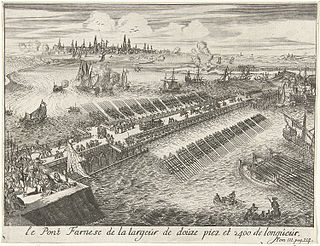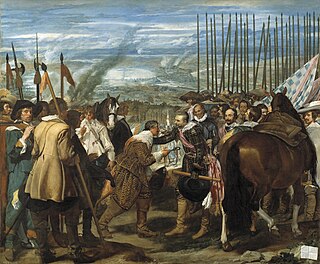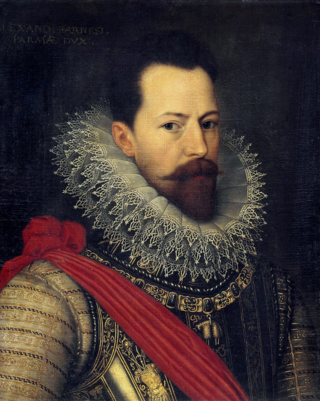
The Eighty Years' War or Dutch Revolt was an armed conflict in the Habsburg Netherlands between disparate groups of rebels and the Spanish government. The causes of the war included the Reformation, centralisation, taxation, and the rights and privileges of the nobility and cities.
The Pacification of Ghent, signed on 8 November 1576, was an alliance between the provinces of the Habsburg Netherlands. The main objectives were to remove Spanish mercenaries who had made themselves hated by all sides due to their plundering, and to promote a formal peace with the rebellious provinces of Holland and Zeeland.

The sack of Antwerp, often known as the Spanish Fury at Antwerp, was an episode of the Eighty Years' War. It is the greatest massacre in the history of the Low Countries.

The fall of Antwerp on 17 August 1585 took place during the Eighty Years' War, after a siege lasting over a year from July 1584 until August 1585. The city of Antwerp was the focal point of the Protestant-dominated Dutch Revolt, but was forced to surrender to the Spanish forces. Under the terms agreed, all Protestants were given four years to settle their affairs and leave the city. Many migrated north, especially to Amsterdam, which became the capital of the Dutch Republic. Apart from losing a high proportion of its mercantile population, Antwerp's trade suffered for two centuries as Dutch forts blockaded the River Scheldt up to 1795.

The siege of Ostend was a three-year siege of the city of Ostend during the Eighty Years' War and the Anglo–Spanish War. A Spanish force under Archduke Albrecht besieged the fortress being held initially by a Dutch force which was reinforced by English troops under Francis Vere, who became the town's governor. It was said "the Spanish assailed the unassailable; the Dutch defended the indefensible." The commitment of both sides in the dispute over the only Dutch-ruled area in the province of Flanders, made the campaign continue for more than any other during the war. This resulted in one of the longest and bloodiest sieges in world history: more than 100,000 people were killed, wounded, or succumbed to disease during the siege.

The siege of Leiden occurred during the Eighty Years' War and the Anglo–Spanish War in 1573 and 1574, when the Spanish under Francisco de Valdez attempted to capture the rebellious city of Leiden, South Holland, the Netherlands. The siege failed when the city was successfully relieved in October 1574.

The siege of Breda of 1624–25 occurred during the Eighty Years' War. The siege resulted in Breda, a Dutch fortified city, falling into the control of the Army of Flanders.

The Battle of the Scheldt also known as the Battle of Walcharen was a naval battle that took place on 29 January 1574 during the Eighty Years' War and the Anglo–Spanish War. The battle was fought between a Dutch rebel Sea Beggar fleet under Lodewijk van Boisot and a Spanish fleet under Julián Romero. The Spanish fleet was attempting to relieve the Spanish held town of Middelburg which was under siege but the fleet under Boisot intercepted them and were victorious with the destruction or capture of nearly fifteen ships. Middelburg as a result then surrendered only nine days later along with Arnemuiden.

The Army of Flanders was a multinational army in the service of the kings of Spain that was based in the Spanish Netherlands during the 16th to 18th centuries. It was notable for being the longest-serving army of the period, being in continuous service from 1567 until its disestablishment in 1706 and taking part in numerous pivotal battles of the Dutch Revolt (1567–1609) and the Thirty Years' War (1618–1648). Because it employed or pioneered many developing military concepts more reminiscent of later military units, enjoying permanent, standing regiments (tercios), barracks, military hospitals and rest homes long before they were adopted in most of Europe, the Army of Flanders has been considered the world's de facto first modern professional standing army. Sustained at huge cost and at significant distances from Spain via the Spanish Road, the Army of Flanders also became infamous for successive mutinies and its ill-disciplined activity on and off the battlefield, including the Sack of Antwerp in 1576.

The battle of Zierikzee was a naval battle between a Flemish fleet and an allied Franco-Hollandic fleet which took place on 10 and 11 August 1304. The battle, fought near the town of Zierikzee, ended in a Franco-Dutch victory. The battle is part of a larger conflict between the Count of Flanders and his French feudal lord, King Philip IV of France (1296–1305).
The siege of Schoonhoven of 1575, also known as the capture of Schoonhoven, was a Spanish victory that took place between 11 and 24 August 1575, at Schoonhoven, Spanish Netherlands, during the Eighty Years' War and the Anglo-Spanish War (1585–1604). On June 28, 1575, the Spanish forces, between 8,000 and 10,000 soldiers, led by Gilles de Berlaymont, Lord of Hierges, and Stadtholder of Guelders, Holland, Zeeland and Utrecht, captured Buren, and on August 7, Oudewater. The Spanish commander continued its successful progress and arrived at Schoonhoven on August 11. After 13 days of siege, and a courageous but futile resistance, the rebel forces led by De La Garde, composed by Dutch, English, Scottish, French and Walloon soldiers, surrendered to the more experienced Spanish troops, on August 24. The population of the town, that were unwilling to help the rebel forces, received Berlaymont with great joy.

The Battle of Borgerhout was a battle during the Eighty Years' War, of the Spanish Army of Flanders led by Alexander Farnese, Prince of Parma, upon a fortified camp at the village of Borgerhout, near Antwerp, where several thousand French, English, Scottish, and Walloon soldiers in service of the recently created Union of Utrecht were stationed. It took place during the reconquest by the armies of Philip II of Spain of the Burgundian Netherlands, whose different provinces had united in 1576 under the Pacification of Ghent to drive out the foreign troops and to grant religious liberty to Protestants.
The Mutiny of Hoogstraten was the longest mutiny by soldiers of the Army of Flanders during the Eighty Years' War. Frederick Van den Berg's attempt to end the mutiny by force, with a siege to recapture the town, ended in defeat at the hands of an Anglo-Dutch army under of Maurice of Nassau. After a period of nearly three years the mutineers were able either to join Maurice's army or rejoin the Spanish army after a pardon had been ratified.

The siege of Grave was a siege that took place between 18 July and 20 September 1602, as part of the Eighty Years' War and the Anglo–Spanish War. The Spanish-held city of Grave was besieged by a Dutch and English army led by Maurice of Orange and Francis Vere respectively. After a siege of nearly two months the city surrendered when a Spanish relief army under Francisco de Mendoza was defeated just outside the city by the besiegers. The defeat was severe enough to cause a major mutiny in the Spanish army.

The siege of Zaltbommel was a campaign that took place during the Eighty Years' War and the Anglo–Spanish War from 15 May to 22 July 1599. The Spanish led by Francisco López de Mendoza y Mendoza launched an offensive campaign around Bommelerwaard, which was defended by an Anglo-Dutch force under the command of Maurice of Orange. A siege on the town of Zaltbommel by Spanish troops was attempted but they had to lift the siege and were defeated in subsequent attempts to regain the initiative. Mendoza retreated and the Spanish army then found itself in chaos: mutinies took effect and as a result further operations were suspended for a number of years. As a result, the Dutch and English followed with a counter-offensive in the Spanish Netherlands.

The siege of San Andreas also known as the siege of Sint-Andries was a military event that took place during the Eighty Years' War and the Anglo–Spanish War from 28 January to 6 March 1600. The Spanish garrison of San Andreas was besieged by an Anglo-Dutch force led by Maurice of Nassau. A Spanish relief force under the command of Luis de Velasco failed to relieve the fort after having been turned back by the besiegers. The fort surrendered after the garrison mutinied and accepted payment from Maurice.

The period between the Pacification of Ghent, and the Unions of Arras and Utrecht constituted a crucial phase of the Eighty Years' War between the Spanish Empire and the rebelling United Provinces, which would become the independent Dutch Republic. Sometimes known as the "general revolt", the period marked the only time of the war where the States–General of all Seventeen Provinces of the Habsburg Netherlands, except Luxemburg, were in joint active political and military rebellion against the Spanish Imperial government through the Pacification of Ghent. The Pacification formulated several agreements amongst the rebellious provinces themselves, and laid down their demands – including the immediate withdrawal of foreign troops from the Netherlands, restitution of old rights and privileges, and self-rule – to king Philip II of Spain.

The years 1579–1588 constituted a phase of the Eighty Years' War between the Spanish Empire and the United Provinces in revolt after most of them concluded the Union of Utrecht on 23 January 1579, and proceeded to carve the independent Dutch Republic out of the Habsburg Netherlands. It followed the 1576–1579 period, in which a temporary alliance of 16 out of the Seventeen Provinces' States–General established the Pacification of Ghent as a joint Catholic–Protestant rebellion against the Spanish government, but internal conflicts as well as military and diplomatic successes of the Spanish Governors-General Don Juan of Austria and Alexander Farnese, Duke of Parma split them apart, finally leading the Malcontent County of Artois, County of Hainaut and city of Douai to sign the Union of Arras on 6 January 1579, reverting to Catholicism and loyalty to the Spanish crown. In response, most of the remaining rebel provinces and cities would forge or later accede to the Union of Utrecht, a closer military alliance treaty that would go on to become the most important fundamental law of the United Provinces, who on 26 July 1581 proclaimed the Act of Abjuration, a de facto declaration of independence from Spain. While the nascent polity was struggling to find a new sovereign head of state, including Matthias of Austria, Francis of Anjou, William "the Silent" of Orange and Robert of Leicester, before giving up and deciding to become a republic by passing the Deduction of Vrancken on 12 April 1588, the Duke of Parma continued his successful military and diplomatic offensive, bringing ever more provinces and cities in the southern, eastern and northeastern parts of the Netherlands back into royalist hands. Parma's reconquests more or less stalled after the Fall of Antwerp (1585), and finally came to an end with the failure of the Spanish Armada and Philip II ordered him to intervene in the French Wars of Religion to prevent the Succession of Henry IV and France becoming a Protestant kingdom. These developments gave rise to a new phase, the Ten Years (1588–1598), that saw significant conquests by the Dutch States Army under the leadership of stadtholders Maurice of Nassau and William Louis of Nassau-Dillenburg, and the Dutch Republic's rise as a commercial great power.

The period between the Capture of Brielle and the Pacification of Ghent was an early stage of the Eighty Years' War between the Spanish Empire and groups of rebels in the Habsburg Netherlands.




















